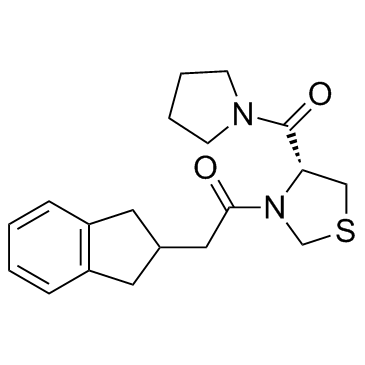130849-58-0
| Name | Z-321 |
|---|---|
| Synonyms |
2-(2,3-dihydro-1H-inden-2-yl)-1-[(4R)-4-(pyrrolidin-1-ylcarbonyl)-1,3-thiazolidin-3-yl]ethanone
2-(2,3-Dihydro-1H-inden-2-yl)-1-[(4R)-4-(1-pyrrolidinylcarbonyl)-1,3-thiazolidin-3-yl]ethanone Ethanone, 2-(2,3-dihydro-1H-inden-2-yl)-1-[(4R)-4-(1-pyrrolidinylcarbonyl)-3-thiazolidinyl]- M2V0Y789FK Z-321 |
| Description | Z-321 is a prolylendopeptidase (PEP) inhibitor. |
|---|---|
| Related Catalog | |
| Target |
PEP[1] |
| In Vivo | Z-321 is a prolylendopeptidase (PEP) inhibitor. In the 100 or 200 mg/kg Z-321-treated groups, mean lordosis quotient (LQ) decreases after administration. However, there is no statistical difference among the values before and after. In contrast, the mean LQ in the 300 mg/kg Z-321-treated females is lower than that before injection (P<0.005). Furthermore, when compare to that in the vehicle-treated control group, mean LQ is also significantly lower (p<0.05). The incidence of soliciting behavior decreases after treatment with 300 mg/kg Z-321, when compare to that before treatment, but there is no statistical difference. The present study also demonstrates that 300 mg/kg Z-321 is effective in inhibiting lordosis behavior without disturbance of locomotor activity[1]. |
| Animal Admin | Femal wistar rats (200 to 250 g) are used and housed under conditions of controlled temperature (23 to 26°C) and photoperiod (14: 10 h, light:dark). Fifty four rats are ovariectomized under ether anesthesia. Two weeks after ovariectomy, sexual behavioral tests are carried out before and after a treatment with Z-321 (100, 200 or 300 mg/kg). Another group of rats, 7 females are given 1 mL/kg of 10% gum arabic as control group[1]. |
| References |
| Density | 1.3±0.1 g/cm3 |
|---|---|
| Boiling Point | 588.8±50.0 °C at 760 mmHg |
| Molecular Formula | C19H24N2O2S |
| Molecular Weight | 344.471 |
| Flash Point | 309.9±30.1 °C |
| Exact Mass | 344.155853 |
| LogP | 2.60 |
| Vapour Pressure | 0.0±1.6 mmHg at 25°C |
| Index of Refraction | 1.622 |
| Storage condition | 2-8℃ |
